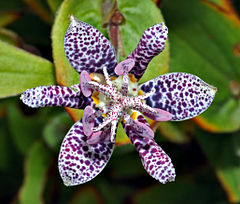Tricyrtis
| Tricyrtis subsp. var. | Toad lily | |||||||||||||||||||||||||||||||||||||||||||||||||||||||
|---|---|---|---|---|---|---|---|---|---|---|---|---|---|---|---|---|---|---|---|---|---|---|---|---|---|---|---|---|---|---|---|---|---|---|---|---|---|---|---|---|---|---|---|---|---|---|---|---|---|---|---|---|---|---|---|---|

|
|
| ||||||||||||||||||||||||||||||||||||||||||||||||||||||
| ||||||||||||||||||||||||||||||||||||||||||||||||||||||||
Tricyrtis is a genus of the botanical family Liliaceae, known in English as Toad lilies. Its native range is from the Himalayas to eastern Asia, including China,[1] Japan,[2] Philippines and Formosa.[3]
They are perennial herbaceous plants that grow naturally at the edge of forests. They prefer shade or part shade and rich, moist soil. Toad Lilies bloom in the fall. They are hardy enough to handle the sudden changes of Midwest(US) winters from mild to blustery cold.[4]
| Standard Cyclopedia of Horticulture |
|---|
|
Tricyrtis (Greek, three convexities, referring to the nectar-bearing sacs at the base of the three outer perianth-segments). Liliaceae. Toad-Lilies. Half-hardy perennials, pretty garden plants; also used for pot culture. Rhizome short-creeping: sts. erect; simple below the infl., leafy: infl. terminal, or laxly dichotomous in the upper axils: fls. few, rather large, somewhat long-pedicelled; perianth usually beautifully spotted inside, campanulate, segms. distinct from the base, lanceolate, acute; stamens 6; ovary oblong, 3-cornered, 3-celled: caps. narrowly oblong, prominently 3-cornered, septicidally dehiscent, erect, usually more than 1 in. long.— About 9 species, native to Japan and Formosa. Monographed by J. G. Baker in Journal Linnaean Society, vol. 17, p. 463 (1879). T. grandiflora, Hort., should be compared with T. hirta var. nigra. It is a name scarcely known to botany. It is said to have orchid-like fragrant fls. in Oct. and Nov. (Baker says the genus has no fragrant fls.). Dutch growers say that T. grandiflora, has white fls. mottled with black. CH
|
Cultivation
- Do you have cultivation info on this plant? Edit this section!
Propagation
- Do you have propagation info on this plant? Edit this section!
Pests and diseases
- Do you have pest and disease info on this plant? Edit this section!
Species
Species include:
- Tricyrtis affinis Makino
- Tricyrtis amethystina Masam.
- Tricyrtis chinensis Hiroshi Takahashi
- Tricyrtis formosana
- Tricyrtis hirta (Thunb.) Hook.
- Tricyrtis latifolia Maxim.
- Tricyrtis macrantha
- Tricyrtis macropoda Miq.
- Tricyrtis stolonifera
- Tricyrtis viridula Hiroshi Takahashi
- Tricyrtis yatabeana Masam.
Gallery
References
- Standard Cyclopedia of Horticulture, by L. H. Bailey, MacMillan Co., 1963
External links
- w:Tricyrtis. Some of the material on this page may be from Wikipedia, under the Creative Commons license.
- Tricyrtis QR Code (Size 50, 100, 200, 500)
Cite error:
<ref> tags exist, but no <references/> tag was found














